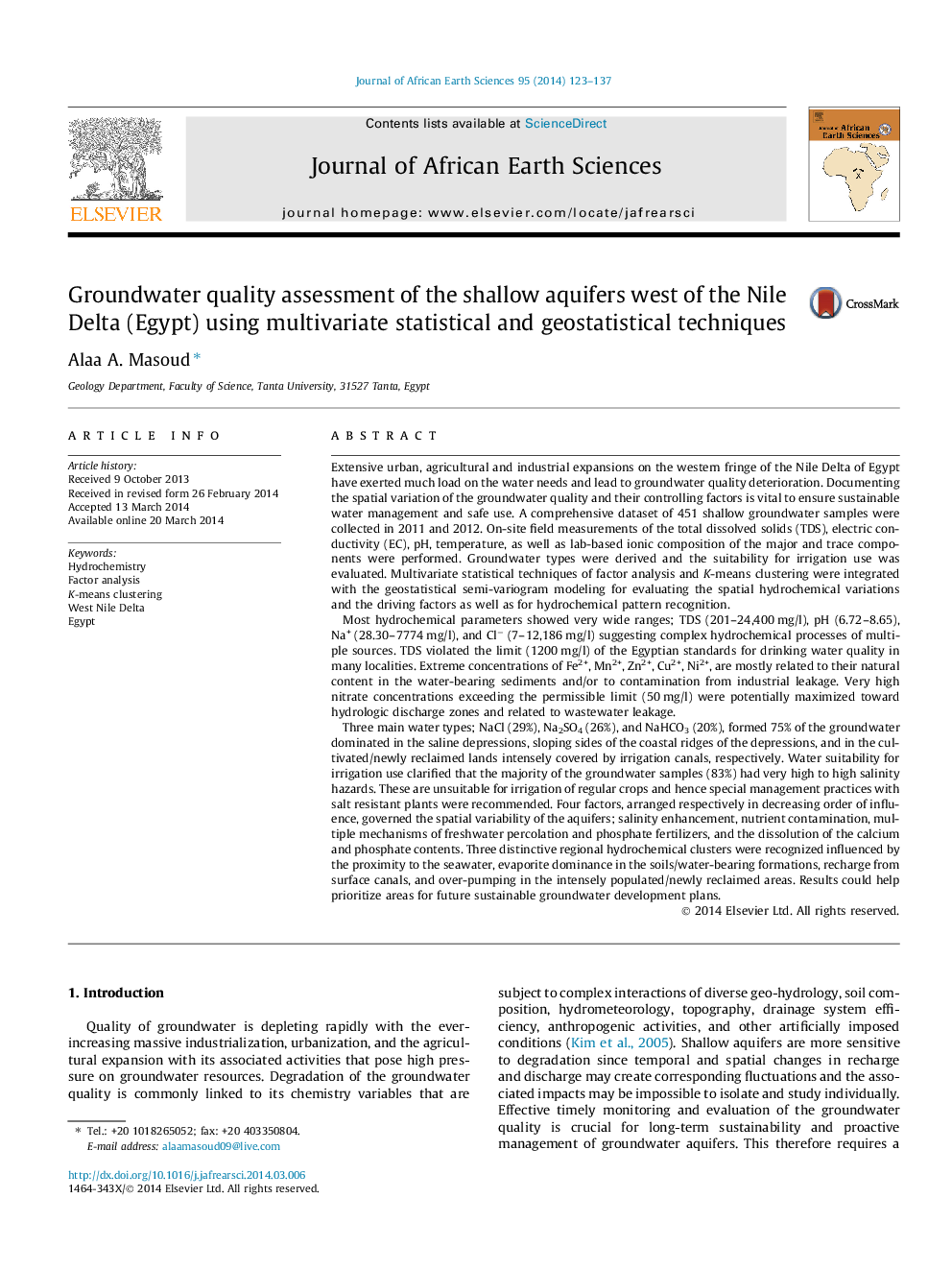| کد مقاله | کد نشریه | سال انتشار | مقاله انگلیسی | نسخه تمام متن |
|---|---|---|---|---|
| 4728822 | 1640211 | 2014 | 15 صفحه PDF | دانلود رایگان |
• Complex processes governed the groundwater quality west of the Nile Delta.
• Concentrations of TDS, trace elements, and nitrate violated the permissible limits.
• Water types of NaCl, Na2SO4, and NaHCO3, formed 75% of the groundwater.
• Very high to high salinity hazards marked 83% of the groundwater samples.
• Four factors influenced the quality and three hydrochemical clusters were recognized.
Extensive urban, agricultural and industrial expansions on the western fringe of the Nile Delta of Egypt have exerted much load on the water needs and lead to groundwater quality deterioration. Documenting the spatial variation of the groundwater quality and their controlling factors is vital to ensure sustainable water management and safe use. A comprehensive dataset of 451 shallow groundwater samples were collected in 2011 and 2012. On-site field measurements of the total dissolved solids (TDS), electric conductivity (EC), pH, temperature, as well as lab-based ionic composition of the major and trace components were performed. Groundwater types were derived and the suitability for irrigation use was evaluated. Multivariate statistical techniques of factor analysis and K-means clustering were integrated with the geostatistical semi-variogram modeling for evaluating the spatial hydrochemical variations and the driving factors as well as for hydrochemical pattern recognition.Most hydrochemical parameters showed very wide ranges; TDS (201–24,400 mg/l), pH (6.72–8.65), Na+ (28.30–7774 mg/l), and Cl− (7–12,186 mg/l) suggesting complex hydrochemical processes of multiple sources. TDS violated the limit (1200 mg/l) of the Egyptian standards for drinking water quality in many localities. Extreme concentrations of Fe2+, Mn2+, Zn2+, Cu2+, Ni2+, are mostly related to their natural content in the water-bearing sediments and/or to contamination from industrial leakage. Very high nitrate concentrations exceeding the permissible limit (50 mg/l) were potentially maximized toward hydrologic discharge zones and related to wastewater leakage.Three main water types; NaCl (29%), Na2SO4 (26%), and NaHCO3 (20%), formed 75% of the groundwater dominated in the saline depressions, sloping sides of the coastal ridges of the depressions, and in the cultivated/newly reclaimed lands intensely covered by irrigation canals, respectively. Water suitability for irrigation use clarified that the majority of the groundwater samples (83%) had very high to high salinity hazards. These are unsuitable for irrigation of regular crops and hence special management practices with salt resistant plants were recommended. Four factors, arranged respectively in decreasing order of influence, governed the spatial variability of the aquifers; salinity enhancement, nutrient contamination, multiple mechanisms of freshwater percolation and phosphate fertilizers, and the dissolution of the calcium and phosphate contents. Three distinctive regional hydrochemical clusters were recognized influenced by the proximity to the seawater, evaporite dominance in the soils/water-bearing formations, recharge from surface canals, and over-pumping in the intensely populated/newly reclaimed areas. Results could help prioritize areas for future sustainable groundwater development plans.
Journal: Journal of African Earth Sciences - Volume 95, July 2014, Pages 123–137
